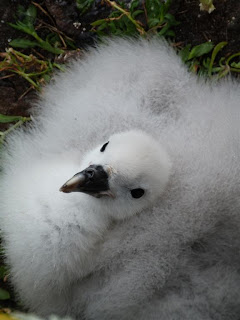Mark Newell organises the seabird research on the island for the Centre for Ecology and Hydrology and tells us how the 2013 season went::
"Well, after four months spent out
on the Isle of May studying the breeding seabirds, I have now had time back on
the mainland to analyse the data and find out just how well the birds performed
this breeding season. Researchers at the
Centre for Ecology & Hydrology have been following the breeding seabirds on
the island for over 40 years, collecting some remarkable data on the diet,
survival and breeding success of six key species.
So how did the year shape up? Well as has been previously mentioned in the
blog ,2013
was a very late season with some species commencing egg laying later than they
have ever done before. A late start
often means that the birds do badly and produce fewer chicks, so we feared the worst. We also knew that the birds had had a
difficult winter and early spring. Poor weather
had taken a heavy toll on the birds with large numbers of puffins and
shags found dead along the East coast. We thought that birds that survived the
difficult winter would return to the island in poor condition and perhaps not
produce many chicks. Our colour ringed studies of shags (birds have unique colour rings
on their legs that can be read with a telescope to see whether or not birds
survive and return to the island) showed that less than half the birds that had
bred in 2012 returned in 2013. We have only had a higher death rate than this
on two previous years in the entire 40 year study. However, on a positive note, those shags
which did survive and return to breed had an above average breeding
season.
As you may have seen on the news, over 3,500 puffins washed
up dead on the east coast in March, so we started the season with some
trepidation. We count all the burrows on the island to assess the puffin
population every five years and luckily a count was due this year. Somewhat surprisingly this count revealed
that the population was little changed from five years ago and the return rate
of individually colour ringed birds coming back to the island was more-or-less
normal. So what does this mean? Well, it’s difficult to say for sure, but
perhaps the distressing winter wreck of puffins observed this year may occur
more often than we thought but this one was just unusual in that the birds
appeared to have died inshore so that the corpses washed up on the coast. Or it
could be that the population had increased since the count five years ago and
that the deaths over winter just reduced the population back to its level five
years ago. Despite the late season the
breeding success of the puffins was about average.
Razorbills were the biggest losers in 2013 with a below
average return rate and the lowest breeding success on record following on from
two poor seasons with less than half of the birds breeding managed to produce a
chick. Although guillemot breeding
success was the lowest since 2008 it was only a little below average while
their return rate was also normal.
The all island count of nesting kittiwakes had revealed a
large drop in numbers from last year.
However, the colour ringed population revealed to us that the return
rate was average. So it looks like the
birds survived the winter in good numbers but that many decided not to breed
due to the poor weather delaying the start of breeding.
Fulmars were the biggest success of 2013. This species
breeds later than the other seabirds on the island, not fledging their chicks
until late in the summer. Fulmars returned to breed at their normal time and
had their most productive season since 2002.
So, in conclusion despite the feeling of doom and gloom at
the onset of the season, for most species it was a fair breeding season
considering the late start. Now for the
winter fieldwork to commence...where do the shags spend the winter? But that is a story for another day."
.JPG)

.JPG)
.JPG)


An interesting result given all the factors involved. Hopefully Razorbills did better somewhere else.
ReplyDeleteWhat superb news, great commentary and a lot of hard work many thanks for your update.
ReplyDelete